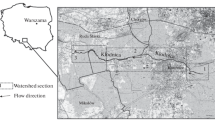Abstract
The major concern of this article is to address the shortcoming and outgoing effects of the human activities on the landscape patterns and their consequences in the Sefidrood River watershed in Iran. A flow of data includes three inputs; each of them belongs to one part of three zones on a fluvial system. The three parts of the Sefidrood River fluvial system include Zone 1, a sub-watershed as degradation modeling site, Zone 2, Sefidrood Dam as dam site, and Zone 3, 17km away from the Sefidrood River path to the Caspian Sea as ending point site. The degradation model in the Zone 1 provides a suitable mean for decision support system to decrease the human impacts on each small district. The maximum number for degradation coefficient belongs to the small district with the highest physiographic density, relatively cumulative activities, and a lower figure for the habitat vulnerability. The human degradation impact were not limited to the upstream. The investigation to the Sefidrood Dam and ending point of the Sefidrood River depicts that sedimentation continues as a significant visual impact in the Sefidrood Dam reservoir and the estuary.
Similar content being viewed by others
References
BEWS J, 1935. Human Ecology [M]. Durban: Natal University Press.
CANTER L W, 1996. Environmental Impact Assessment [M]. 2nd ed. New York: McGraw-Hill.
Department of Environment, 1992. National report [R]. Tehran: DOE of Iran. (in Persian)
ECCLESTON C H, 2000. Environmental Impact Assessment [M]. 2nd ed. New York: McGraw-Hill.
FORMAN R T T, GORDON M, 1986. Landscape Ecology [M]. New York: John Wiley and Sons.
MAKHDOUM M F, 1992. Environmental units: an arbitrary ecosystem for land evaluation [J]. Agriculture, Ecology and Environment, 41(2): 299–213.
MAKHDOUM M F, 1993. Fundamental of Land Use Planning [M]. Tehran: Tehran University Press. (in Persian)
MAKHDOUM M F, 1995. Curriculum guidelines for MSc in environmental economics [Z]. UNEP, NETTLAP Pub, (14): 231–236.
MAKHDOUM M F, POURFARHADI K, RAFIEI M, 1997. A Manual for Physical Planning and Impact Assessment [M]. Tehran: Ministry of Housing and Urbanization. (in Persian)
MAKHDOUM M F, 2002. Degradation model: a quantitative EIA instrument, acting as a decision support system (DSS) for environmental management [J]. Environmental Management, 30(1):151–156.
MANDER U, JONGMAN R H G (eds.), 2000. Landscape Perspectives of Land Use Changes [M]. Southampton: WIT Press.
MILLER G T, 1979. Living in the Environment [M]. Baltimore: Wadsworth.
Ministry of Energy, 1976. Sefidrood Dam Lake Sediments [M]. Tehran: Deputy Minister for Water Resources Management. (in Persian)
NAKAGOSHI N, OHTA Y, 1992. Factors affecting the dynamics of vegetation in landscape of Shimokamagari Island southwestern Japan [J]. Landscape Ecology, 7(7): 111–119.
Plan and Budget Organization, 1968. Dam making in Iran [R]. Tehran: Office for Information and Reports. (in Persian)
Plan and Budget Organization, 1994a. Complete climatology studies of Kurdistan Province: climate report Vol.1 [R]. Tehran: Hamoon Office. (in Persian)
Plan and Budget Organization, 1994b. Complete demographic studies of Kurdistan Province: population report Vol.5 [R]. Tehran: Hamoon Office. (in Persian)
Plan and Budget Organization, 1994c. Complete geology studies of Kurdista Province: geology report Vol.2 [R]. Tehran: Hamoon Office. (in Persian)
Plan and Budget Organization, 1994d. Complete soil and land use studies of Kurdistan Province: soil report Vol.3 [R]. Tehran: Hamoon Office. (in Persian)
Plan and Budget Organization, 1994e. Complete vegetations studies of Kurdistan Province: vegetation report Vol.4 [R]. Tehran: Hamoon Office. (in Persian)
SCHUMM S A, WOODMANSEE R G, RISSER P G (eds.), 1988. Variability of Fluvial Systems in Space and Time in Rosswel: Scale and Global Change [M]. New York: Wiley, 225–249.
WALL D, 1994. Green History [M]. London: Routledge.
YOUNG R, 2001. Uncertainity and the Environment [M]. London: Edward Elgar.
Author information
Authors and Affiliations
Additional information
Biography: Forood AZARI DEHKORDI (1966–), male, a native of Tehran, Iran, Ph. D. candidate at Hiroshima University, specialized in environmental impact assessment and landscape ecology. E-mail: forood@hiroshima-u.ac.jp
Rights and permissions
About this article
Cite this article
Dehkordi, F.A., Makhdoum, M.F. & Nakagoshi, N. Sefidrood river sub-watershed-dam-estuary and degradation model: A holistic approach in Iran. Chin. Geograph.Sc. 13, 328–333 (2003). https://doi.org/10.1007/s11769-003-0038-z
Received:
Issue Date:
DOI: https://doi.org/10.1007/s11769-003-0038-z




